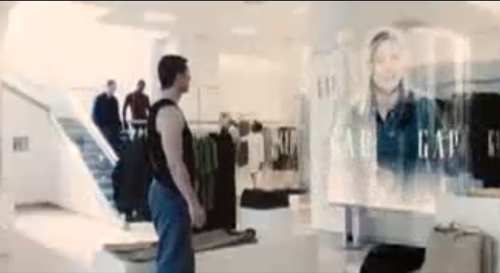
When I talk to marketing executives about the Smart Body, Smart World paradigm — how sensor-laden devices like wearables give us access to new domains of information and what we can do with that information — they always bring up the movie Minority Report.
The 2002 sci-fi crime thriller has become the reference point people imagine when they think about the future of advertising: specifically, the scene in which Jon Anderton (Tom Cruise) walks through the mall and billboards show him ads based on his mental state (stressed out) and context (on a journey).
This depiction of the future makes sense if you take the status quo of advertising in 2002 — delivering messages via screens to acquire new customers and persuade them to try your product — and bolt on new technology like biometric scanning. There are multiple examples of marketers today doing simplified versions of this, using billboards that adapt content based on gender and age.
A Dumb Vision Of The Smart Future
But this is a pretty dumb vision of the “smart” future. Smarter marketing goes far beyond advertising.
The Smart Body, Smart World paradigm requires a different approach to marketing, an approach focused on delivering services and utility rather than just advertising. Sensor devices collect data that’s intimate by nature, in contexts where marketers have never before had access. That intimacy lends itself to trust-based interactions, where trust is earned with utility.
The Nest home thermostat, for example, uses motion sensors and machine-learning algorithms to predict your schedule — but users don’t think it’s creepy because it saves them 20% on their heating and cooling bill. The Jawbone UP knows your daily commute and how well you slept — but its usefulness is quantifiable, helping wearers move, on average, 26% more per day.
Many sensor-laden devices don’t have displays; even the ones that do, like Google Glass, are better suited for “engagement marketing” or “relationship marketing” rather than advertising. For example, Glass might be an appropriate platform for a bank to show a user’s “safe to spend” balance – like financial services company Simple does on its mobile app – while the customer is out shopping. But that approach wouldn’t be well-suited to cross-selling a mortgage.
Sensors Change Everything
The Smart Body, Smart World paradigm accelerates transformations that are already occurring in marketing. In particular, sensor devices require marketers to:
Shift their priorities from acquisition to engagement. Today, marketers spend the majority of their budgets on the early stages of the customer journey, especially reaching new customers through channels like TV advertising and in-store displays. Smart Body, Smart World technologies lend themselves more toward engaging customers you already have, building on trust you’ve already earned. This shift from acquisition to engagement requires marketers to rethink their priorities and redistribute their spending accordingly.
Make better use of all the data they are collecting. Sensor devices produce an enormous amount of data — up to thousands of data points per minute per person. Making use of all this data is a new skill for marketers. Think about the Nike+ FuelBand, for example. In the past, Nike’s marketers would not have known much about their customers — they relied on what data they could get from retailers and whatever market research they commissioned. Now they know what time their customers wake up, whether they had a good day and how fit they are compared with their friends. Acting on this data in a way that benefits the user and the company requires an enormous shift from the way they used data in the past.
Reconfigure privacy practices to deliver contextually relevant services. Current privacy practices are woefully inadequate for the age of smartphones and sensors. Today, marketers routinely collect more data than they need for service delivery. In doing so, they are assuming unnecessary risk (as we see in the near-daily hacking of major enterprises), and they also make it harder to recognize business opportunities obscured by mountains of data. In Forrester’s research, we’ve found that many consumers would actually be willing to share more data if they knew it would be used to deliver genuinely useful services. But they object, with good reason, to sharing data without getting real value in return.

These shifts will transform marketing in a far deeper way than the superficial Minority Report vision. Imagine a future in which marketers influence products, pricing and branding based on deep insights of how people actually use their product. A future in which marketers anticipate customer needs before they’re expressed — while staying on the right side of the line separating useful from creepy.
A future in which marketers actually help customers change their own behavior to the benefit of the customer, not just the marketer. Marketers have this future within their grasp if they can recognize that the mall in Minority Report is not what we should be building.
I’ll be speaking more about how marketers make these transformations at Forrester’s Forum for Marketing Leaders on April 18 and 19 in Los Angeles. Join us if you can!

















